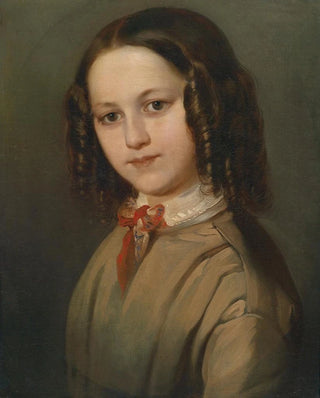Art print | Childhood portrait of Mélanie Deinhardstein - Anton Romako


View from behind

Frame (optional)
Portrait of Mélanie Deinhardstein's childhood by Anton Romako – Captivating introduction
The "Portrait of Mélanie Deinhardstein's childhood" by Anton Romako is a work that transcends the simple frame of painting to become a true window into the soul of a young girl. Captured with extraordinary delicacy, this representation invites us to delve into a universe where innocence and youthful curiosity meet. Romako, through this artwork, manages to immortalize not only Mélanie's features but also the very essence of her being. Every brushstroke seems to breathe life, and one can almost hear the laughter of childhood echoing beyond time.
Style and uniqueness of the work
Anton Romako's style is distinguished by his ability to blend realism with a touch of romanticism. In this art print, the nuances of colors and the subtly diffused light on Mélanie's face create an intimate and warm atmosphere. The meticulous details, such as the reflections in her sparkling eyes and the delicate texture of her hair, testify to the artist's technical skill. Romako does not merely depict a child; he evokes an emotion, a story, a moment frozen in time. The composition, centered on Mélanie's face, draws the eye and allows the viewer to engage in a silent dialogue with the subject, thus revealing the depth of her character and dreams.
The artist and his influence
Anton Romako, born in 1832 in Austria, was a painter whose work is often marked by a particular sensitivity to human emotions. Influenced by the Romantic movement, he sought to capture not only the appearance of his subjects but also their deepest feelings. His career, rich in portraits and genre scenes, demonstrates a constant desire to explore the complexity of human nature. Romako established himself in the art world thanks to his refined technique and unique vision, influencing many contemporary and future artists. The portrait of Mélanie Deinhardstein is a perfect example of his approach, where each stroke is charged with meaning and

Matte finish

View from behind

Frame (optional)
Portrait of Mélanie Deinhardstein's childhood by Anton Romako – Captivating introduction
The "Portrait of Mélanie Deinhardstein's childhood" by Anton Romako is a work that transcends the simple frame of painting to become a true window into the soul of a young girl. Captured with extraordinary delicacy, this representation invites us to delve into a universe where innocence and youthful curiosity meet. Romako, through this artwork, manages to immortalize not only Mélanie's features but also the very essence of her being. Every brushstroke seems to breathe life, and one can almost hear the laughter of childhood echoing beyond time.
Style and uniqueness of the work
Anton Romako's style is distinguished by his ability to blend realism with a touch of romanticism. In this art print, the nuances of colors and the subtly diffused light on Mélanie's face create an intimate and warm atmosphere. The meticulous details, such as the reflections in her sparkling eyes and the delicate texture of her hair, testify to the artist's technical skill. Romako does not merely depict a child; he evokes an emotion, a story, a moment frozen in time. The composition, centered on Mélanie's face, draws the eye and allows the viewer to engage in a silent dialogue with the subject, thus revealing the depth of her character and dreams.
The artist and his influence
Anton Romako, born in 1832 in Austria, was a painter whose work is often marked by a particular sensitivity to human emotions. Influenced by the Romantic movement, he sought to capture not only the appearance of his subjects but also their deepest feelings. His career, rich in portraits and genre scenes, demonstrates a constant desire to explore the complexity of human nature. Romako established himself in the art world thanks to his refined technique and unique vision, influencing many contemporary and future artists. The portrait of Mélanie Deinhardstein is a perfect example of his approach, where each stroke is charged with meaning and






